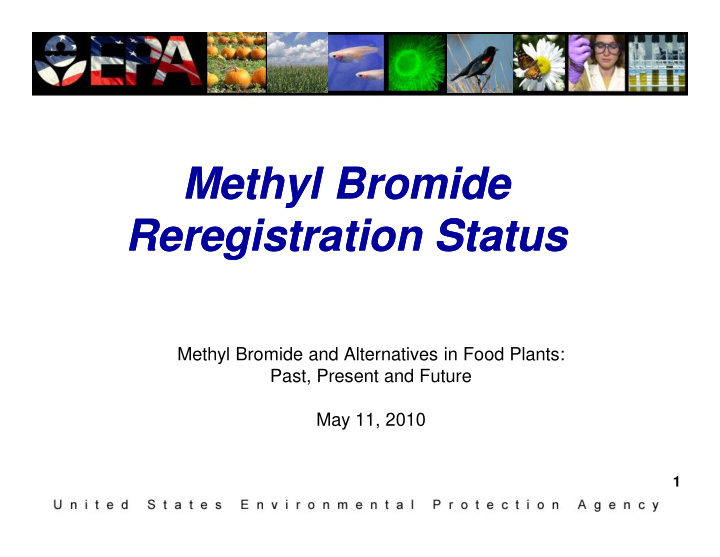



Methyl Bromide Methyl Bromide Reregistration Status Reregistration Status Methyl Bromide and Alternatives in Food Plants: Past, Present and Future May 11, 2010 1
Overview of Regulatory Overview of Regulatory Process Process • Decision Issued in August 2006 • Covers registered “commodity uses” • Developed through a 6-phase public participation process • Soil uses of methyl bromide are addressed through a separate decision 2
Risk Assessment Overview Risk Assessment Overview • Dietary and drinking water exposures do not exceed levels of concern • Concerns for acute exposures to residential bystanders • Concerns for acute worker risks 3
Mitigation Measures Mitigation Measures • Site-specific FMPs • Buffer zones • Posting of treated areas and commodities • Respiratory and air monitoring • New aeration procedures • Record keeping 4
Fumigant Management Plans Fumigant Management Plans • Fumigant users must prepare a written, site- specific plan before fumigation begins • FMPs help: • Ensure fumigators successfully plan all aspects of a safe and effective fumigation • Prevent accidents, ensure label compliance, and identify appropriate procedures in case of accidents or unforeseen events • Demonstrate compliance with label requirements and are a tool for verifying compliance 5
Major Elements of FMPs Major Elements of FMPs • General site and applicator information • Treatment and aeration procedures • Buffer zones • Authorized on-site personnel • Personal protective equipment • Posting and notification plans • Record keeping • Emergency procedures • Site security • Hazard communication 6
Buffer Zones Buffer Zones • Required during treatment and aeration periods • Minimum buffer of 10 feet • Based upon application rates, loss rates, ventilation systems, and enclosure/chamber/structure volumes 7
Posting and Notification Posting and Notification • Provide workers with access to material safety data sheets • Treated areas and treated commodities must be clearly identified • Vehicles leaving the fumigation site must be placarded with appropriate DOT warning signs • Provisions for community notification 8
Respiratory Protection Respiratory Protection • Required for anyone entering any area where concentrations exceed 1 ppm for an 8-hour TWA • Procedures established for discontinuing the use of respiratory protection 9
Aeration Procedures Aeration Procedures • Minimum aeration times • 4 hours if mechanically ventilated • 12 hours if passively ventilated • Concentration within the treated commodity must be no greater than 5 ppm at the end of the aeration process 10
Record keeping Record keeping • Records must be kept on-site • Must be made available to all fumigation workers, other on-site workers and government authorities • Maintain for at least 2 years 11
Post-Decision Activities Post-Decision Activities • Data Call-In issued in July 2009 • Buffer zones were re-modeled for several scenarios based on new data • Site-specific buffer zones were modeled for certain sites administered by USDA-APHIS • Buffer zone calculator and compliance manual are under development • Discussions of protocols to characterize exposures from handler and forklift work activities and measure area and/or breathing zone air concentrations • Voluntary cancelation of unsupported uses 12
Additional Changes Additional Changes Being Considered Being Considered • Updating FMP, posting, PPE, record keeping requirements • Amending the aeration requirement to ensure risks are not exceeded • Changes to labeling of treated commodities • Including best management practices on labels • Including Information on labels on how to comply 13
Future Activities Future Activities • Continue to work with stakeholders on potential changes to mitigation • Amend TRED/RED • Issue another DCI that calls for new product labels (new labels would not appear for at least 8 months after DCI issued) • Implement reassessed tolerances • Respond to comments • Develop templates and tools to help users comply with labels • Registration Review 14
Recommend
More recommend